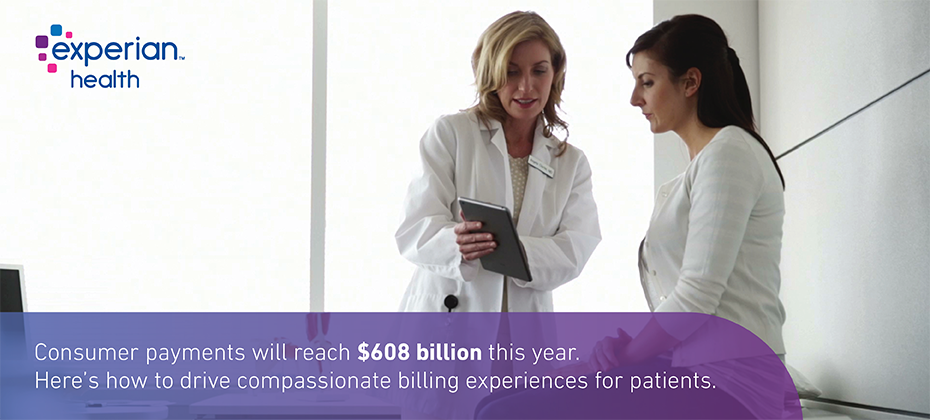
Consumers are bearing a bigger burden of healthcare costs than ever before. As the third largest payer behind Medicare and Medicaid, many patients find themselves struggling to foot the bill, with implications for hospitals and health systems.
According to a TripleTree report published late last year, consumer payments will reach $608 billion by 2019, thanks to growing enrollments in high deductible health plans (HDHP), decreasing payer reimbursements, and increasingly personalized insurance plans that come at a premium. Almost half of those under the age of 65 are enrolled in an HDHP.
These rising out-of-pocket payments can cast a long shadow on the patient’s experience. The payment process is often stressful and confusing, and many are unable to pay without careful budgeting or some form of financial support. And for providers, the growing admin costs of chasing payments can create a serious cash-flow problem. A forward-looking, patient-centered approach to billing is critical.
A good starting point for providers who want to reduce friction around payments, optimize revenue and build a positive relationship with consumers is to look at how data and technology can improve customer payment processes.
You can do this in three ways: transparent pricing, patient billing tailored to each individual’s financial situation, and simplified admin processes all provide greater clarity and reassurance for patients.
Make patient billing easier with transparent pricing
New guidelines from the Centers for Medicare and Medicaid Services (CMS) call for hospitals to list chargemaster pricing on their websites, so consumers can make informed decisions about their treatment and plan accordingly. Unfortunately, the complexity of pricing structures and the way it’s presented can still be very confusing for consumers.
CMS Administrator Seema Verma tweeted that “While the information hospitals are posting now isn’t patient-specific, we still believe it is an important first step & sets the stage for private third parties to develop tools & resources that are more meaningful & actionable.” Patients are encouraged to tell the CMS if they can’t find pricing info on their hospital’s website, using the hashtag #WheresThePrice.
However, there’s been a lot of criticism that the CMS requirements do not meet consumer expectations. Health leaders should aim to provide consumers with accurate personalized estimates, using data-driven technology. Most healthcare organizations already have the basic data they need to generate estimates for basic services, including:
- claims data
- real-time eligibility and benefits information
- payer contracts
- charge description master (CDM) information.
Riley Matthews, Senior Product Manager for the Patient Estimate Suite at Experian Health, says: “We’re finding facilities are getting backlogged with calls while patients are trying to call in to speak to a live person to try to get an estimate… If a patient is comfortable understanding what they owe, they’re going to be much more comfortable paying for their services.”
Giving patients accurate estimates upfront empowers them to understand their financial responsibility so they can make quicker, better decisions, and improve their overall experience.
Personalize patient payment plans for a better patient experience
The growth of consumerism in healthcare calls for a friendlier approach to the billing process, both for a better patient experience and to avoid non-payment. This means recognizing each patient as an individual with different needs and tailoring your offer at each stage of the revenue cycle.
Some will be able to pay their whole bill up front, while others might need to spread it over a number of months, or seek support from a charity. Issuing the bill and hoping it gets paid isn’t going to cut it – you’ll be wasting time and money on repeated, unnecessary collection attempts. Instead, why not personalize each patient’s payment plan based on their individual financial situation? No surprises for them, no missed payments for you.
Insights from credit data can help you identify the best collection approach for each patient, so you can work with them to find financial assistance, set up payment plans in advance, or outsource payment to an appropriate co-payer.
Simplify the admin process to improve patient collections
These days, most of our life admin is done online, from banking to travel. Healthcare needs to do the same. You can make healthcare payments easier for your patients by giving them access to their accounts online, so they can manage it when it suits them.
This is about making the revenue cycle as frictionless and consumer-friendly as possible. Data-driven technology makes it easy for patients to obtain accurate price estimates, set up or modify their payment plans, check their insurance details, combine payments to different providers, and facilitate mobile healthcare payments.
Terry Manifesto, a Senior Director at El Camino Hospital, worked with Experian Health to allow patients to access and manage their data through a self-service portal: “We’re providing a lot more estimates than we could before, because it’s 24/7, on the go – a patient can use it from their mobile device, from their laptop, or their desktop.”
With healthcare consumerism and outcomes-based care trending upwards, the dynamics of healthcare finance are shifting. A collections approach based on compassion and simplification is the key to building trust and optimizing revenue at the same time.


